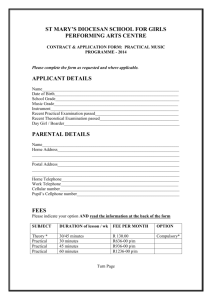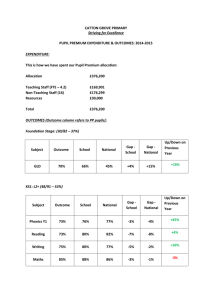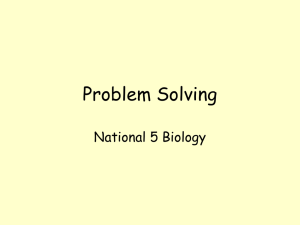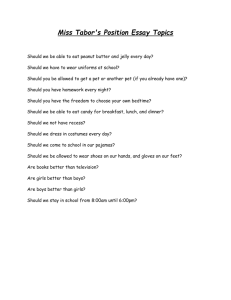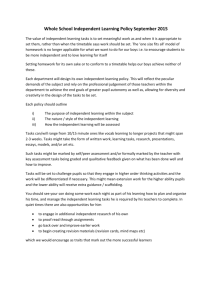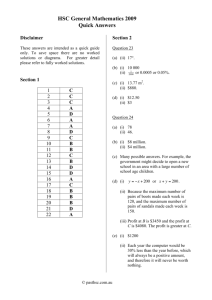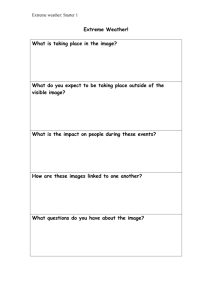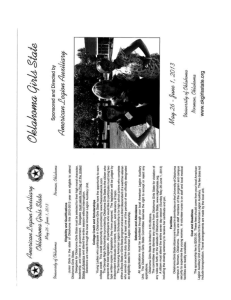T&L workshop including starters and plenaries
advertisement
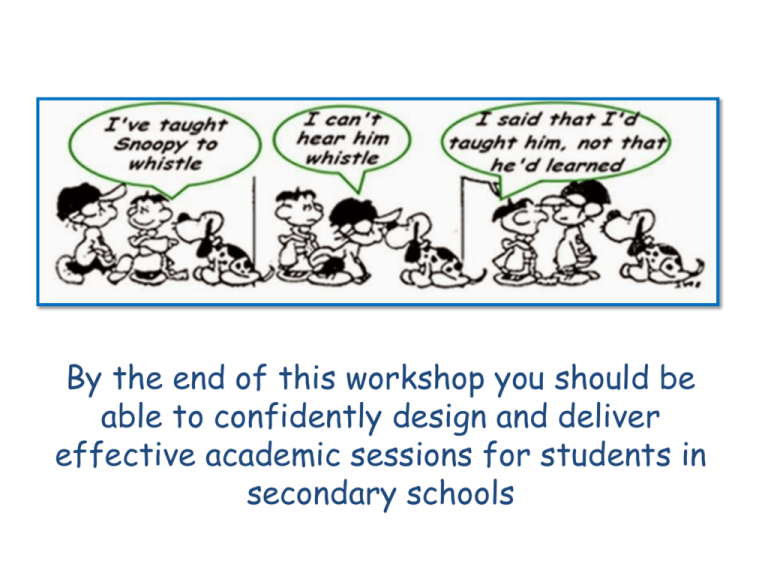
By the end of this workshop you should be able to confidently design and deliver effective academic sessions for students in secondary schools Workshop Overview The psychology of learning Nigel The ingredients of a good lesson Nigel Gender differences and how to engage both males and females Emma Starters, lesson objectives, plenaries Emma Break at 11.10am Teaching and Learning strategies Emma & Nigel Plenary and Evaluation Emma Activity 1) What are the main differences between girls and boys’ a) learning styles and b) attitudes in the classroom? 2) What teaching strategies do you think would work to engage/reward girls and boys? Girls V’s Boys Girls are more likely to Boys are more likely to 1. be good listeners 1. do well when using mathematical-logical thinking. 2. print neatly and follow directions carefully. Girls do not like to ‘mess-up’ their work. 2. settle for messy handwriting and disorganized work. 3. sit calmly in their seats. 3. need space to spread out their materials; move around in that space. 4. gather facts before they draw conclusions. 4. deduce conclusions from general statements. 5. need concrete examples when learning abstract principles. 5. be comfortable with mathematical symbols and general ideas in math. 6. need to talk about their subject before beginning a writing 6. lose focus on a writing task and spend little time talking project. about what they plan to write. 7. work well in pairs or in small cooperative groups. 7. Prefer to work alone; argue over who will lead when working in a group 8. entertain themselves during boring parts of the school day. 8. act out and disrupt the class when bored. 9. pay attention to more than one activity at a time. 9. act as if they don't care about learning when they are confused or frustrated. 10. Respond well to personalised praise 10. Respond well to praise 11. Systematic and good planners http://www.eduguide.org/article/boys-and-girls-have-different-learning-styles Group Activity Evaluate the most suitable teaching strategies/methods that would most engage/reward girls/boys Top Tips for Teaching Girls • • • • • • • • • Think-pair-share – avoids girls being put on the spot (perfectionist mentality) Praise girls for taking risks as well as being good (something that girls avoid) I like the way you…but have you thought about…? Could you expand on that idea…? Self-/peer assessment – allows girls to reflect and improve Mini-saga (summarise…in 50 words) Paired work over group work If working in groups – teacher to select groups – its awkward to choose Girls don’t like to mess up their work so give them scrap/rough paper to work on first Competitive tasks with clear goals/targets Top Tips for Teaching Boys • • • • • • • • • • • Bite sized chunks Stretching but achievable targets Variety of teaching methods and activities Competitiveness and structure to lessons Purposeful objectives/activities – real world, big picture Reflect boys interest e.g. sport, books, music Self/peer assessment – aim to improve ability to reflect and evaluate Think-pair-share – avoids boys shouting out answer and allows time for quality answers. Use graphics, pictures, and storyboards Boys are more kinaesthetic so get them ‘doing’ or use demonstration as a teaching strategy Move around the classroom Starter Activities During successful starters: • Pupils engage fully in learning from the outset; • They gain an understanding of the objectives and purpose of the lesson; • There is a sense of pace; • Pupils spend most of their time on-task and focused on learning. DFES Key Stage 3 National Strategy. Pedagogy and practice Starter EXAMPLES Starter Activity: Diamond 9 • The Governors at JCC, at the request of the Environment Group has decided to introduce a range of measures to make the school more eco-friendly. • The Governor has asked for your advice. • Create a diamond 9 of the different measures. • At the top would be the most effective in terms of their environmental effect and also in terms of saving money Starter Plot the following different motivational factors on to a scatter diagram Retention Productivity Odd One Out. • • • • • Tourist International student Refugee Assylum seeker Immigrant Answer! Show me the answer! Using mini-whiteboards, true/false cards, hand signals, different coloured cards etc. pupils must show you the answer to a series of questions ANAGRAMS • • • • • • • ETPNROITF ENUESSALREVE VEEABRKEN NOECOAMOFSIESCLE MAIDMRETK Students compete to decode the VITDUCPROTIY anagrams. FIEFCNCIEY Students then must be able to clearly define the key terms. What might have happened before the photo was taken? What might be happening now? What might happen after? Right OR Wrong? Scenario Should Top Shop/Man take-over New Look? Implications? Graffiti or Art? Can you name the product being advertised? Bring in a Prop Starters – Top Tips Make it immediately accessible to all or most pupils Keep it short – less than ten minutes Hook the pupils’ interest Make instructions and outcomes clear Activities should be challenging, active and demand high-level thinking. Teaching and Learning STRATEGIES FOR SUCCESSFUL SESSIONS Task What might a pupil look like who is engaged in learning? Top Tips • Pace and challenge • Questioning is effective • Learning objectives are inclusive and challenging • Variety of engaging activities • Develops thinking skills Active engagement. People learn best when they are interested, involved and appropriately challenged by their work – when they are engaged with their learning Engagement is about promoting those approaches to teaching and learning that help pupils understand subject knowledge and its application and that demand their active participation DFES 2004 How can we engage students? 1. Activate prior knowledge 2. Challenge - to stimulate and interest pupils. How can we engage students? 3. Cooperative group work 4. Metacognition – pupils thinking about thinking How can we engage students? 5. Different modes of representing information 6.Scaffolding How can we engage students? 1. Activate prior knowledge – learning is an active process of constructing knowledge and developing understanding. Pupils make ‘meaning’ by connecting new knowledge and concepts to ideas and knowledge they already possess 2. Challenge - to stimulate and interest pupils. How can we engage students? 3. Cooperative group work – according to Vygotsky’s ‘zone of proximal development’ the assistance of peers helps the development of thought in an individual. 4. Metacognition – pupils thinking about thinking – assess, reflect, evaluate, How can we engage students? 5. Modes of representing information – the brain is forced to work hard when it has to convert one mode to another e.g. from text to diagrammatic form. 6.Scaffolding – providing structures and guides to support thinking Paired Activity Task: Design a one hour session for a group of 15 year olds about a learning topic of your choice. Resources: Use the PLUS+ Scheme workshop session plan as a guidance template Be prepared to share and justify your plan The Importance of Plenaries Draw together the learning of the whole group and the individual Help determine the next steps in learning Summarise and take stock of learning so far Consolidate and extend learning Highlight what has been learned and also how it has been learned. Plenaries EXAMPLES HEAD-something that has made you think HEART- something that you have felt BIN-something you did not find interesting BAG- something you will remember and take away Bin Key Word Bingo Create a list of 12 key terms Ask students to create a 9 box grid Students to choose 9 of the key terms and write them onto their Bingo card Teacher reads a definition – students decides whether they have the key word Student shouts Bingo if they get a line (or full house) Students has to read key words – and some key terms back to the teacher Assess your Learning Ask students to reflect on the lesson objectives and assess themselves Students hold up five fingers if they are fully confident that they have met the learning objectives Individual students can be questioned to check learning and understanding One thing that surprised you during the session Two questions that you would like to know the answer to Three things you enjoyed about today Four top-tips that you have learnt today Evaluation Focus area Engaging starter activity Clear and inclusive learning objectives Variety of activities and ‘experiences’ Use of time Level of challenge Independent learning opportunities Plenary Out of 10
